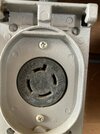I just made one of these for a L15-30 plug at my winery. I wired X and Z on the plug to the two hot leads on 10-30 receptacle and the ground to the neutral pin. Then plugged my 10-30 Gen 2 plug into this cable and good to go. Car accepts 208V just fine. Most municipal chargers are 208V from 480 3 phase. I started with a short 10-30 to 6-50 adapter from a different chargung situation amd just replaced the 6-50 plug with the L15-30 one.
For your situation, Buy something Like this (or any 6-20 extension cord)
And this
Cut the extension cord/adapter about 12-15” from the receptacle end. Strip the sheathing from about 3” then strip the ends from the 3 wires inside (should be white black and green). Wire the green wire to the G terminal of the L15-20 plug. Then the white and black to X and Z (doesn’t matter which) amd you are good to go. Just remember the L means locking so you put the plug into the outlet and twist to the right to engage and lock the connection.
Or buy the premade one above. Costs about $20 more but you don’t need to do anything else other than buy the 6-20 Tesla UMC adapter.
Oh, and the L15-20P to 14-50R with a 14-50 UMC adapter will tell the car it can pull up to 40 amps which will blow the circuit breaker at the winery. You can tell the car to only pull 16A but it won’t do this automatically. Better to have the UMC equipped with the proper plug so it won’t pull too much amperage.




